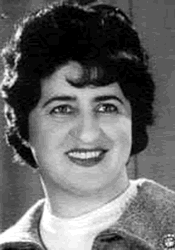Rikle Glezer Story ( from the net http://typo3.ort.org/?id=136 )

Born on 17 December 1924, Rikle Glezer was only sixteen when the Nazis invaded her home city of Vilna. She wrote several popular songs during her years of imprisonment in the ghetto. Most of her compositions were lyrics set to the melodies of popular songs: for example, her sarcastic indictment of ghetto life under the Nazi regime, 'You, my ghetto', was set to a melody by Isaak Dunajewski titled 'Oh, my Moscow'. Rather than depicting the beauty of Vilna, however, Glezer's lyrics tell of the grim reality of smuggling food under conditions of disease, exhaustion, and starvation.
Glezer's best-known song was the popular 'S'iz geven a zumertog' (It was a summer's day), which mentions the forest of Ponar, one of the most notorious sites of Nazi mass murder, where thousands of men, women and children from Vilna and the surrounding towns were shot and buried in mass graves. The simple and evocative lyrics were set to the melody of a popular Yiddish theatre song of the inter-war years, 'Papirosn' (Cigarettes), composed by Hermann Yablokoff.
Shortly after composing the song, Glezer was put on a train to be deported to a camp. The teenager managed to escape from the train, and joined the partisans in the forests surrounding Vilna. The youngest member of the partisan group, Glezer continued to write between military actions. Of the 60,000 Jews of Vilna who were alive in 1939, she was one of approximately 3,000 who survived to see the liberation of her home city by the Red Army.
Sources
Freund, F., Ruttner, F. et al, (Eds). (1992). Ess Firt Kejn Weg Zurik.: Geschichte und Lieder des Ghettos von Wilna, 1941-1943. Vienna, Picus.
Katsherginski, S. and Leivick, H. (Eds). (1948). Lider fun di Getos un Lagern. New York, Alveltlekher Yidisher Kultur-Kongres.
from http://www.create-on.com/images/cjs/gilbert_CSO_article.pdf
"....In 1941, for example, 18-year old Rikle Glezer described how she experienced the establishment of the Vilna ghetto:
It was a summer's day, sunny and lovely as always
And nature then had so much charm.
Birds sang, hopped around cheerfully.
We were ordered to go into the ghetto.
Oh, just imagine what happened to us!
We understood: everything was lost.
Of no use were our pleas that someone should save us
We still left our home.
The road stretched far; it was difficult to walk
I think that, looking at us, a stone would have cried.
Old people and children went like cattle to be sacrificed
Human blood flowed in the street.
While Glezer painfully chronicled the events she had witnessed and the emotional
state in which this had left her community, another young inmate of the Vilna ghetto,
Hirsh Glik, celebrated Jewish endurance. In his well-known song 'Zog nit keynmol'
(Never say), written in response to the recently-received news of the Warsaw ghetto
uprising in 1943, he defiantly encouraged his fellow inmates and underground
resistance fighters:
Never say that you are walking the final road,
Though leaden skies obscure blue days
The hour we have been longing for will still come,
Our steps will drum—we are here!
...... The well-known Jewish partisan, poet, and
collector Shmerke Katsherginski wrote soon after the war that the songs would help
future generations 'to fathom the soul of our people'. They reveal to us the kinds of
things that Jews thought about their fellow inmates or those who held power over
them, the shattering realities about which they sang to their unknowing children, how
they tried to distract themselves with memories of home or dreams of freedom, how
they tried to make sense of or play down what they were experiencing through humor
or denial, how they wanted to remember what their lives had been, and how they
imagined they would be remembered. The songs help us think about the victims as
human beings, unsure of what was happening to them, full of intersecting and
conflicting wishes, hopes, fears, and predictions. Perhaps most importantly, they
allow us to remember Holocaust victims in the context of the rich and diverse
experiences they represented, and not only the mechanized process of their
destruction."
Shirli Gilbert